| Author |
Message |
|
Evin Yarby
Location: Arizona Joined: 04 Dec 2014
Posts: 3
|
 Posted: Thu 04 Dec, 2014 3:06 pm Post subject: Antique rapier how old? Posted: Thu 04 Dec, 2014 3:06 pm Post subject: Antique rapier how old? |
 |
|
Please help me identify this sword. What time period is it from? Is there a part missing? See the bumps in the middle of the swept parts on the hilt. Lovely details in the blade. Is it meant to be hung on a wall because the back side is flat and not chiseled. What might it be worth?
I have scoured images for one like this, thanks for helping.
 Attachment: 53.53 KB Attachment: 53.53 KB
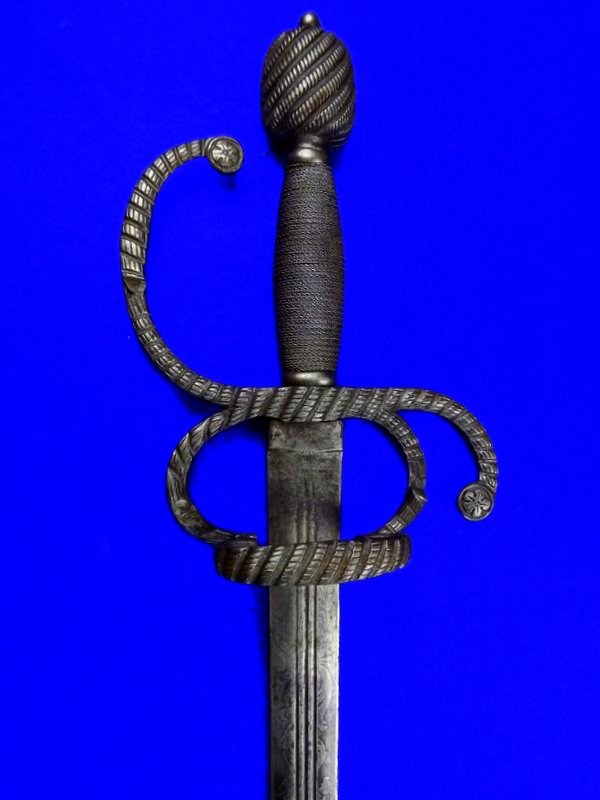
Hilt
 Attachment: 48.23 KB Attachment: 48.23 KB

Blade
 Attachment: 56.99 KB Attachment: 56.99 KB
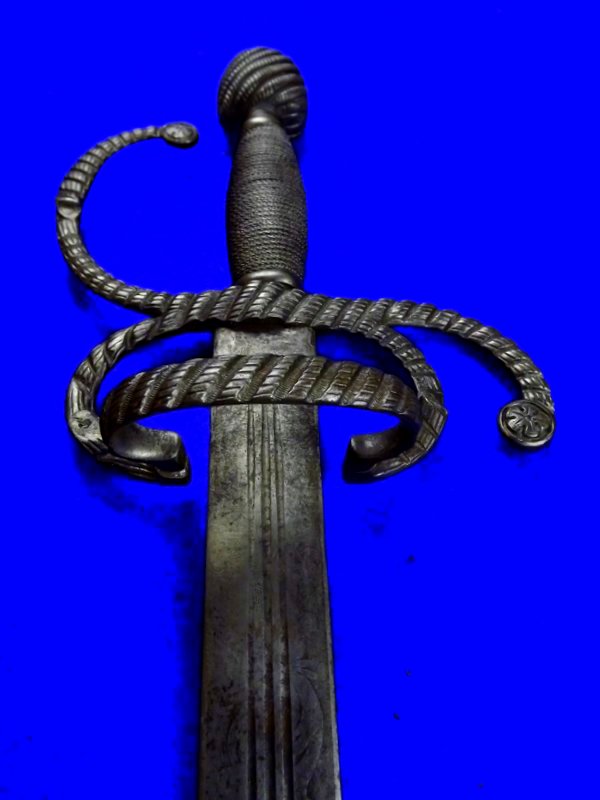
 Attachment: 37.96 KB Attachment: 37.96 KB
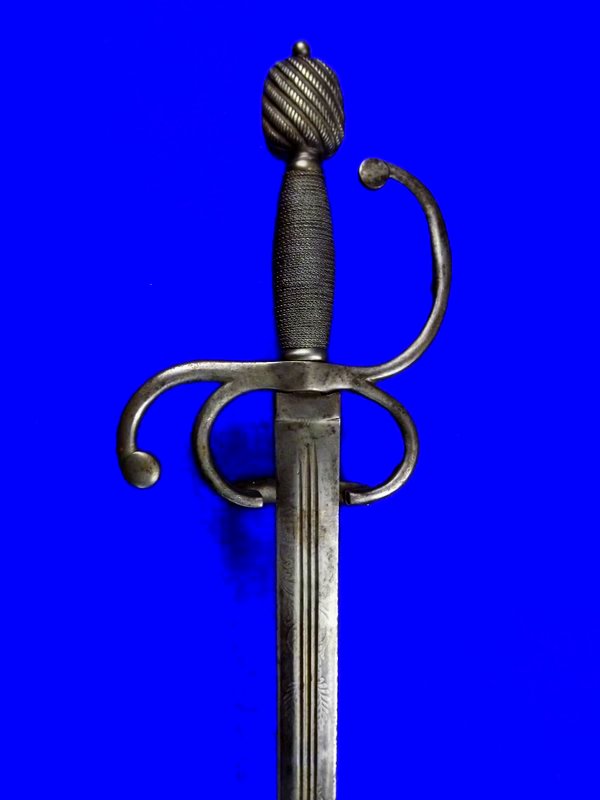
flat back
|
|
   |
 |
David Cooper

|
 Posted: Fri 05 Dec, 2014 12:25 am Post subject: Posted: Fri 05 Dec, 2014 12:25 am Post subject: |
 |
|
The style of blade etching seems very 19th century which is at odds with the style of the hilt. Could it be a Victorian copy?
The journey not the destination
|
|
  |
 |
|
E.B. Erickson
Industry Professional
|
 Posted: Fri 05 Dec, 2014 5:38 am Post subject: Posted: Fri 05 Dec, 2014 5:38 am Post subject: |
 |
|
OK, that appears to be a composite.
The blade may be from the 16 or 1700s, but the etching (as David noted) is 1800s. So we have an old broadsword blade re-etched.
Also, a broadsword blade in a rapier hilt is a no go with the edges sharpend well up into the finger rings as this blade appears to be.
The hilt is probably Victorian or early 20th century. Probably not from the 1600s, although they did a decent job of capturing the curves of a period rapier. I wouldn't be surprised to find that the hilt is cast.
Please bear in mind that these are opinions based on a photo; I might have a different opinion if I could examine the sword in hand.
--ElJay
|
|
   |
 |
Nathan Robinson
myArmoury Admin


|
|
    |
 |
David Wilson

Location: In a van down by the river Joined: 23 Aug 2003
Posts: 803
|
 Posted: Fri 05 Dec, 2014 4:00 pm Post subject: Posted: Fri 05 Dec, 2014 4:00 pm Post subject: |
 |
|
I wonder if the blade is actually from a kaskara.... thoughts?
David K. Wilson, Jr.
Laird of Glencoe
Now available on Amazon: Franklin Posner's "Suburban Vampire: A Tale of the Human Condition -- With Vampires" https://www.amazon.com/dp/B072N7Y591
|
|
   |
 |
Craig Peters

|
 Posted: Fri 05 Dec, 2014 6:37 pm Post subject: Posted: Fri 05 Dec, 2014 6:37 pm Post subject: |
 |
|
When I saw the hilt, it actually reminded me of some of the work done by A&A. Compare the "flat back" side of the sword loop guard with the A&A Town Guard. Stylistically, this feels like an A&A custom hilt (if not blade) to me.
Are there examples of antique rapiers with a "flat" back like the one shown here?
|
|
  |
 |
Nathan Robinson
myArmoury Admin


|
|
    |
 |
Craig Peters

|
 Posted: Fri 05 Dec, 2014 8:31 pm Post subject: Posted: Fri 05 Dec, 2014 8:31 pm Post subject: |
 |
|
|
No, not the counter guards. I mean the front side of the rapier Evin posted has a writhen look; I'm not sure what the technical term is. The reverse side of the rapier is completely smooth. Are there known period examples with design work like this?
|
|
  |
 |
Nathan Robinson
myArmoury Admin


|
 Posted: Fri 05 Dec, 2014 11:43 pm Post subject: Posted: Fri 05 Dec, 2014 11:43 pm Post subject: |
 |
|
| Craig Peters wrote: | | No, not the counter guards. I mean the front side of the rapier Evin posted has a writhen look; I'm not sure what the technical term is. The reverse side of the rapier is completely smooth. Are there known period examples with design work like this? |
Oh, I see what you're saying.
Yes, the backsides of many hilts are left unadorned. This is the side left sitting near the body and does not show while worn. It is common.
.:. Visit my Collection Gallery :: View my Reading List :: View my Wish List :: See Pages I Like :: Find me on Facebook .:.
|
|
    |
 |
|
Don Stanko
|
 Posted: Sat 06 Dec, 2014 4:07 am Post subject: Posted: Sat 06 Dec, 2014 4:07 am Post subject: |
 |
|
|
The lack of a counter guard was common in the 19th century. It is my understanding that the sword was made for display purposes only. It would allow the sword to hang flush against the wall. I don't know if that is the case with this sword since it appears to be a composite piece.
|
|
  |
 |
|
Radovan Geist
|
 Posted: Sun 07 Dec, 2014 10:53 pm Post subject: Posted: Sun 07 Dec, 2014 10:53 pm Post subject: |
 |
|
For me itīs difficult to say anything certain on the age / provenience of the sword, so just some thoughts:
1. As Nathan said, some period rapiers have very little / none decoration on the backside.
2. There are 16th - early 17th century rapiers with very simple hilts, without any counterguard, with only branches and a side ring, quite similar to this one. But:
3. From what I see on the picture, the hilt was altered - it seems that the loopguard has been chopped-off. See the attached picture.
4. This rapier is probably not a part of "case of rapiers", as it has a full handle and a full pommel.
5. Therefore when I saw it my first thought was that itīs a wallhanger (possibly even a quite old reproduction - 19th C ?) which somebody tried to alter to make it more historically "plausible".
But I realize that it could be a far-off speculation:) Anyways, as Evin noted in his very first entry, there is a part of hilt missing.
 Attachment: 44.86 KB Attachment: 44.86 KB
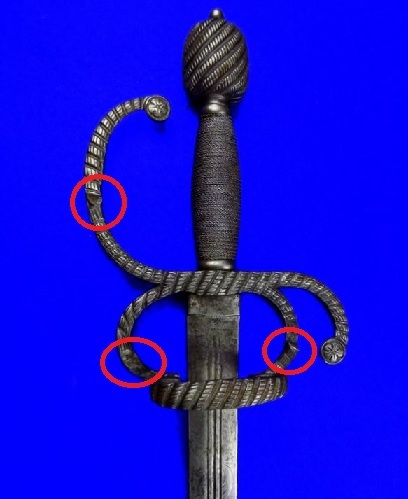
|
|
  |
 |
Craig Johnson
Industry Professional

|
 Posted: Mon 08 Dec, 2014 5:26 am Post subject: Rapier Hilt Posted: Mon 08 Dec, 2014 5:26 am Post subject: Rapier Hilt |
 |
|
Interesting piece. I agree with most that the blade is a bit of an odd fit, but the hilt may have been made for it as the fore ring and arms are the right size for the blade which if it had been made for a narrower ricasso it may have not fit. The guard I suspect is cast. The outer guard anchor points are obvious as detailed and this is exactly how one would do it to cast this piece.
The biggest tell to me that it is modern is the way the fore ring is attached. It looks to be a bit crude and not blended in as would be seen on earlier pieces or dressed as one would suspect a piece with this proud construction technique.
I suspect that the sweeps fell off or where removed rather than to make it look older. Possibly due to damage or some other need.
Smooth back and interior is fine. Rapiers are designed to be seen and used but they waisted little effort on the points one would not see when worn on the hip for any type of functional piece. The area of the hilt block (where the blade passes through the cross seems a bit inelegant to me.
The bessels top and bottom of the grip and the grip it self seem to be newer than the rest in form and age.
I agree on the etch as well, seems a bit at odds for a period piece.
As Eljay says all based on the pics and its always best to have something in hand to do this kind of speculation.
Be well my friends
Craig
|
|
    |
 |
|
Evin Yarby
Location: Arizona Joined: 04 Dec 2014
Posts: 3
|
 Posted: Mon 08 Dec, 2014 9:56 am Post subject: Thanks for the info. Posted: Mon 08 Dec, 2014 9:56 am Post subject: Thanks for the info. |
 |
|
My initial reaction was that a crossguard piece was broken off. The blade does not fit symmetrically centered with the hilt. It is slightly off to right side. My initial impression is also a composite of a couple different parts. Whoever put it together did a compelling Job of making the parts match up. I could not find any cast marks.
Thanks for the help!
 Attachment: 75.23 KB Attachment: 75.23 KB
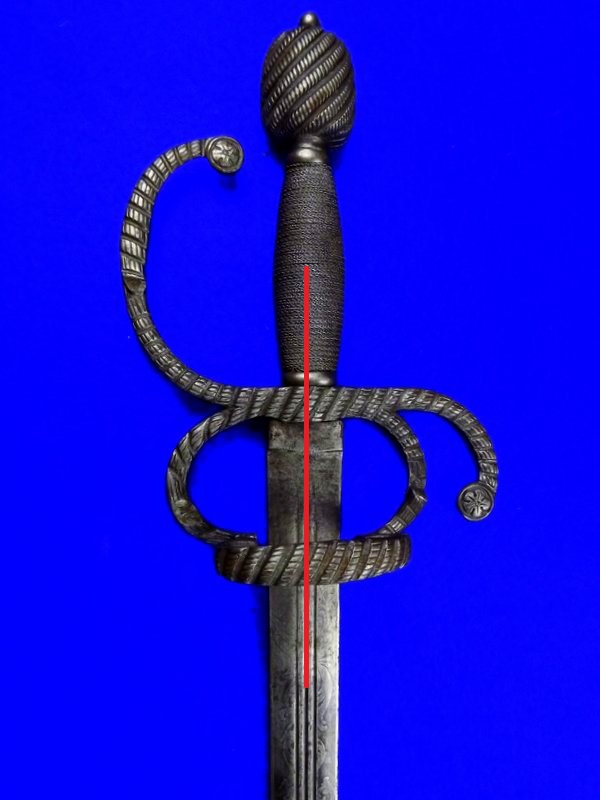
|
|
   |
 |
|
Ralph Grinly
|
 Posted: Tue 09 Dec, 2014 3:56 am Post subject: Posted: Tue 09 Dec, 2014 3:56 am Post subject: |
 |
|
|
Certainly no real knowledge of rapiers, but it does look like a portion of the crossguard has been removed at some stage. Could it have been removed due to possible serious damage? How *were* these type of rapier guards actually made ? Were they made through casting..or from working up from solid steel ?. If casting..it's quite possible a hidden casting flaw broke after sword was created, and a still usable weapon was 'tidied up" ?
|
|
  |
 |
|
Evin Yarby
Location: Arizona Joined: 04 Dec 2014
Posts: 3
|
 Posted: Thu 18 Dec, 2014 1:07 pm Post subject: Value update thanks all. Posted: Thu 18 Dec, 2014 1:07 pm Post subject: Value update thanks all. |
 |
|
|
The sword sold on ebay for 900 bucks.
|
|
   |
 |
|
|

